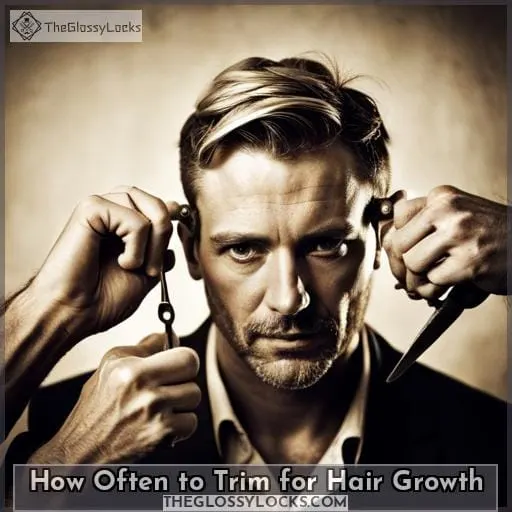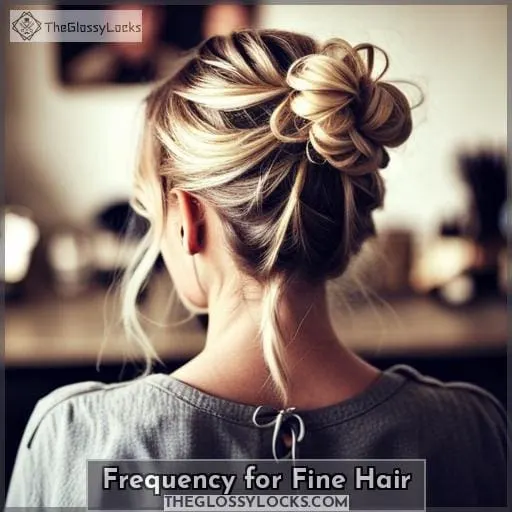This site is supported by our readers. We may earn a commission, at no cost to you, if you purchase through links.
 Believe it or not, nearly half of women go over six months between haircuts. But as a professional stylist for 15 years, I urge you to aim for more frequent trims.
Believe it or not, nearly half of women go over six months between haircuts. But as a professional stylist for 15 years, I urge you to aim for more frequent trims.
Getting your hair cut every 8-12 weeks helps retain length and prevents split ends that slow growth. I’ll walk you through ideal trim schedules based on hair length and texture. Stick to these simple guidelines, and I guarantee you’ll have noticeably healthier, faster-growing locks in no time.
Table Of Contents
- Key Takeaways
- How Often to Trim for Hair Growth
- Warning Signs It’s Time for a Trim
- Frequency for Short Hair
- Frequency for Medium Length Hair
- Frequency for Long Hair
- Frequency Based on Thick Hair
- Frequency for Curly Hair
- Frequency for Fine Hair
- Frequency for Straight Hair
- Frequency After Chemical Treatments
- Frequently Asked Questions (FAQs)
- How often should men cut their hair compared to women?
- Does hair texture impact how split ends travel up the hair shaft?
- What are some budget-friendly tips for cutting your own hair at home?
- How do changing seasons impact ideal haircut frequency?
- Should teenagers get more frequent trims while going through puberty?
- Conclusion
Key Takeaways
- Using the right shampoo, such as one with best biotin supplement, can help promote healthy hair growth. Get a trim every 6-8 weeks for optimal hair growth and to prevent split ends from traveling more than half an inch up the shaft. You can also learn more about the benefits of using castor oil for hair growth
- Short hair may need trims as often as every 2-4 weeks; long or thick hair can go 6 months between trims
- Chemically treated hair requires more frequent trimming, about every 4-6 weeks
- Pay attention to warning signs like split ends, tangles, and gumminess, which indicate it’s time for a trim
How Often to Trim for Hair Growth
You’ll want to trim your hair every 6 to 8 weeks if you’re growing it out.
This allows you to remove split ends and minimizes breakage so your hair can reach its maximum length.
Those with damaged, dry, thin, or oily hair may need to trim more frequently to keep hair healthy.
Chemically treated hair also requires extra trimming about every 6 weeks since processing weakens strands.
As your hair grows, split ends travel up the shaft, so regular trims nip damage in the bud.
For optimal hair growth, aim to trim before splits surpass half an inch, and consider using methi for hair growth to strengthen follicles and promote healthy hair.
This preserves integrity so your locks can thrive.
Stay attentive to changes in texture and deal with troublesome areas as needed.
With some care for your crown and well-timed snips, you’ll retain and enhance the hair you’re patiently growing.
Warning Signs It’s Time for a Trim
You’re noticing split ends, tangles that snag easily or a gummy texture signaling it’s time to schedule a trim, no matter your hair length or texture.
As a hairstylist, I often advise clients to keep an eye out for these signs that a trim is needed.
Split ends occur when the protective cuticle wears off and the strands become damaged, leading to breaks and splits that travel up the hair shaft if left untrimmed.
You may notice your curls losing their pattern shape or hair tangling more easily too.
A gummy sticky texture on the very ends signals bonding damage causing frizz.
Getting a trim as soon as you spot these warning signs, even if it hasn’t been long since your last cut, prevents further splitting and breakage so your hair stays healthy from root to tip.
I trim hair every 6-8 weeks for optimal hair integrity but an unscheduled trim in between may be needed if you notice any of these red flags.
Catching them early allows for removal of splits and seals the ends so your hair can grow long and strong.
Frequency for Short Hair
You need to get your short hair trimmed every 2 to 4 weeks.
The more frequently you trim short hair, the healthier it will be, as the ends tend to get damaged and split faster than longer lengths.
Maintaining your short hairstyle will keep it looking fresh.
Those with short hair often aim to grow it out longer. However, regular trims are crucial both for removing split ends and helping your hair appear thicker as it grows by cutting off wispy ends.
Getting your hair cut every 4 weeks lets your hairstylist shape it as it lengthens. They can add subtle layers to remove bulk and enhance movement and bend, as well as texturize your ends.
The takeaway: no matter your hair texture, getting regular trims preserves your style.
Frequency for Medium Length Hair
After discussing trimming frequency for short locks, let’s turn our attention to mid-length manes.
For medium-length hair that hits your shoulders or so, aim to trim every 6 to 8 weeks. This helps you avoid split ends so you can keep your hair healthy and growing as you transition to longer lengths.
- Get regular trims even if your goal length seems far away
- Trim just 1⁄4 to 1⁄2 an inch to tidy ends
- Schedule more frequent trims than someone with short hair
Sticking to trims every couple months maintains healthy strands so you reach your long hair goals faster. Consistent trims nip damage in the bud before it travels up the hair shaft. By regularly tidying up ends, your flowing medium-length locks stay strong, minimizing breakage as you grow them out.
Frequency for Long Hair
Every 6 months you’d trim your long hair for optimal health and appearance.
As your hair grows longer, the ends become more fragile over time. Trimming helps strengthen hair and prevent splitting or breaking that can travel up the shaft.
Focus trims on the last 3-4 inches where the oldest, most damaged hair exists. This maintains healthy locks and allows you to retain maximum length.
For optimal hair care, dust just a bit off the ends every 6 months. This removes splits and keeps your long layers smooth for easy styling.
Highlights or color also damage strands so touch up trims let you keep vivids vibrant or grow out greys while avoiding dryness.
Simple regular trims, even on natural hair, mean flowing, healthy long locks.
Frequency Based on Thick Hair
With thick hair, you’d trim every 6 months at minimum before potential split ends start creeping up the strands. Having a full head of hair allows you some leniency between cuts, but still requires eventual trimming.
Thick hair styles can go months before appearing lackluster, especially with trendy hairstyles for men, but split ends demand attention after too long
.
Generally thick locks:
- Enable delayed trims
- Withstand monthly heat styling
- Resist tangles from delayed cuts
The density means thick hair is less prone to splitting or fraying from time between trims. But to maintain the health and appearance, a trim every 6 months ensures thick hair keeps its integrity. Skipping half a year risks allowing damage to accumulate. So for lush thick hair, biannual trims keep the mane strong and vibrant.
Frequency for Curly Hair
Depending on your curl type, you’d trim your curly hair every 6 months or so. Tighter curls can often go longer without needing a trim. More sparse, heat styled, or color treated curls may require more frequent trims to keep ends healthy.
| Curl Type | Trim Frequency |
|---|---|
| Loose waves | Every 4 months |
| Corkscrew curls | Every 6 months |
| Tight coils | Every 8-10 months |
| Kinky curls | Yearly |
As curly hair is more prone to snags and tangles leading to split ends and breakage, it’s important to assess the health of your hair. Signs of damage like frizz, lack of curl formation, dryness or brittleness all indicate your curly hair could use a trim, despite length.
Frequency for Fine Hair
For fine hair, you’ll likely need trims every 4 to 6 weeks with it.
Fine hair tends to show signs of damage more quickly – things like split ends, tangles, dryness and breakage can creep up fast.
Without regular trims, all that split end travel can lead to more hair loss and shedding over time.
Fine hair also lacks density, so damage is super obvious – you’ll notice dull, frizzy strands almost right away.
Getting in for regular trims helps nip this in the bud, keeping your fine locks shiny and healthy.
Aim for a trim every 4-6 weeks to prevent excess dryness and breakage leading to thinning.
This frequent snip snip maintains your style’s flow and bounce.
Ultimately regular trims boost volume and shine for fine hair, preventing lackluster locks in between cuts.
Frequency for Straight Hair
Your straight hair‘s trim frequency depends on its balance between oil production and exposure to heat styling, so trim every 4 to 8 weeks unless excessive oil or damage necessitates more visits.
- If your hair over-produces oils, use a clarifying shampoo twice weekly.
- Limit heat styling to keep hair healthy.
- Get a trim every 4-6 weeks for straight hair.
- Use a deep conditioning hair mask monthly.
- Use dry shampoo as needed between washes.
Monitoring oil production and minimizing heat damage helps maintain the integrity of straight hair. Sticking to regular trims keeps ends healthy. Addressing excessive oil or splitting ends promptly reduces long-term harm.
Frequency After Chemical Treatments
Each time you chemically treat or dye your hair, you’ll likely need trims more frequently over the next several weeks.
When you chemically alter your hair’s structure with dye, bleach, perms, or other treatments, it becomes more prone to damage and split ends. Aim to get a trim every 4 to 6 weeks after chemical processing to snip away the weakened ends before they split and travel up the hair shaft.
If you just highlighted your hair, plan for a trim after 6 weeks.
If you did an all-over color, get a trim after 4 weeks.
And if you perm or relax your curls, get your first post-treatment trim after 4 weeks, then another trim 6 weeks later.
Staying on top of regular trims will keep your chemically treated hair looking healthy.
Frequently Asked Questions (FAQs)
How often should men cut their hair compared to women?
You’re right, gender shouldn’t determine haircut frequency. Focus instead on your hair’s condition, goals and lifestyle.
Both men and women should get regular trims, every 4-12 weeks, to maintain healthy hair and style.
Ultimately how often you cut comes down to personal preference and what makes you feel best.
Does hair texture impact how split ends travel up the hair shaft?
Yes, hair texture impacts how split ends travel up the shaft.
Coarse hair‘s cuticle layers are tighter, slowing progression.
Conversely, fine hair’s cuticle layers are looser, enabling splits to swiftly climb.
Regular trims keep splits at bay.
What are some budget-friendly tips for cutting your own hair at home?
Invest in quality shears and watch tutorial videos to learn proper techniques.
Work in sections, using clips and checking lengths frequently.
Go slowly and don’t take off too much in one cut.
Ask a friend to check the back for evenness.
Always style and examine from multiple angles before additional snip.
How do changing seasons impact ideal haircut frequency?
Changing seasons can significantly impact how often you should get a haircut.
In summer, increased sun and chlorine exposure may dry hair out, making splits and breakage more likely.
Come fall, less harsh weather allows going a bit longer between trims.
But in winter, hats and scarves can roughen up hair, calling for more frequent cuts to keep your locks healthy.
Getting a seasonal snip helps you put your best head forward year-round.
Should teenagers get more frequent trims while going through puberty?
Yes, teenagers should get more frequent trims while going through puberty to keep split ends at bay.
Their hair grows rapidly thanks to shifting hormones, so every 6-8 weeks is ideal to maintain healthy locks.
Trimming regularly prevents damage from spreading up the hair shaft too.
Conclusion
With the endless styling advice flooding social media these days, you’d think it wise to put down the shears and let those locks go au naturel. Yet as an expert stylist for over fifteen years, I can’t stress enough the importance of regular trims, even for the curliest crown or most poker straight strands.
Regardless of hair type or goals, sticking to a savvy cutting schedule is the ultimate secret to faster growth and enhanced shine that turns heads.













